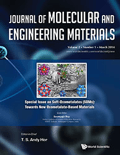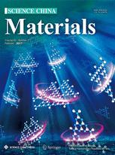
MATERIALS SCIENCE & ENGINEERING R-REPORTS
Scope & Guideline
Elevating Research Standards in Materials Science
Introduction
Aims and Scopes
- Materials Design and Characterization:
The journal focuses on the development and characterization of new materials, including metals, polymers, ceramics, and composites, highlighting their structural, mechanical, and functional properties. - Nanomaterials and Advanced Structures:
A significant area of research involves nanomaterials and their unique properties, including two-dimensional materials, nanocomposites, and hierarchical structures, which are pivotal for applications in electronics, energy storage, and sensing. - Sustainable and Green Materials:
There is a consistent emphasis on sustainability, including the development of biodegradable materials, recycling strategies, and the use of renewable resources in material synthesis and processing. - Energy Applications:
Research related to energy conversion and storage materials, such as batteries, supercapacitors, and solar cells, is a core focus, addressing the urgent need for efficient and sustainable energy solutions. - Biomedical Applications:
The journal also explores materials for biomedical applications, including drug delivery systems, tissue engineering, and biosensors, emphasizing biocompatibility and functional performance. - Computational Materials Science:
A strong component of the research includes computational approaches to materials science, such as machine learning, density functional theory, and molecular dynamics simulations, which aid in predicting material behaviors and properties.
Trending and Emerging
- 2D and 3D Materials:
There is a growing focus on two-dimensional materials and their heterostructures, alongside advancements in three-dimensional printing technologies for creating complex architectures and devices. - Smart and Functional Materials:
Research on smart materials that respond to environmental stimuli, such as temperature and light, is on the rise, indicating a shift towards applications in sensors, actuators, and responsive systems. - Electrocatalysis and Energy Storage Innovations:
A notable trend includes the exploration of novel electrocatalysts, particularly non-precious metal catalysts and high-entropy materials for energy-related applications, reflecting the urgent demand for efficient energy conversion technologies. - Bioinspired and Biocompatible Materials:
The development of materials inspired by biological systems and designed for biomedical applications is increasingly prominent, emphasizing the integration of materials science with biology and medicine. - Machine Learning and AI in Materials Science:
An emerging theme is the application of machine learning and artificial intelligence techniques in materials design and discovery, showcasing the potential for accelerating research and optimizing material properties.
Declining or Waning
- Traditional Metal Alloys:
While metal alloys have been a staple of materials science, the recent trend shows a decline in papers focusing solely on traditional metal alloy systems, as research shifts towards high-entropy alloys and complex concentrated alloys. - Conventional Polymers without Functionalization:
Research on basic polymer materials without specific functionalization or application has decreased, as the field moves towards more advanced, multifunctional, and sustainable polymer systems. - Static Structural Materials:
There has been a noticeable reduction in studies that focus exclusively on static structural properties of materials, as there is a growing interest in dynamic, responsive, and smart materials that can adapt to changing conditions.
Similar Journals

Oxford Open Materials Science
Pioneering Insights for Tomorrow's TechnologiesOxford Open Materials Science is a pioneering peer-reviewed journal published by Oxford University Press that serves as a leading platform for the open-access dissemination of original research in the field of materials science. With its inception in 2021, the journal has quickly established itself as a significant contributor to the scholarly community, achieving a commendable Q2 ranking in the Materials Science (miscellaneous) category as of 2023, and holding the 252nd position out of 463 in the Scopus ranking for general materials science. This journal not only fosters innovative research and collaboration among experts, practitioners, and students but also emphasizes the importance of unrestricted access to knowledge. With the open-access model, it ensures that high-quality research is universally accessible, paving the way for advancements in material applications and technologies. Oxford Open Materials Science is dedicated to promoting the exchange of ideas and findings essential for the scientific progress of materials science, making it an invaluable resource for today's researchers and industry professionals.

Journal of Molecular and Engineering Materials
Catalyzing Progress in Materials Engineering and Molecular ResearchThe Journal of Molecular and Engineering Materials, published by World Scientific Publishing Co Pte Ltd, is a leading peer-reviewed journal that focuses on the intricate relationship between molecular science and engineering practices. With the ISSN 2251-2373 and E-ISSN 2251-2381, this journal aims to foster the exchange of cutting-edge research and developments within the fields of materials science, molecular engineering, and related applications. Although the journal currently does not operate under an Open Access model, it remains a vital resource for researchers, professionals, and students seeking in-depth knowledge and innovative methodologies in material design and engineering. The journal's esteemed reputation is reflected in its commitment to publishing high-quality research that addresses contemporary challenges and opportunities in material science, thereby contributing to advancements in technology and industry.

Science China-Materials
Leading the Charge in Materials Research Excellence.Science China-Materials is an esteemed peer-reviewed journal dedicated to advancing the field of materials science, published by SCIENCE PRESS. With a strong focus on innovative research and applications, this journal provides an essential platform for disseminating groundbreaking findings in materials development, characterization, and engineering. Since its inception, Science China-Materials has achieved an impressive Q1 ranking in the Materials Science (miscellaneous) category, reflecting its commitment to quality and the impact of its publications, as indicated by its 86th percentile ranking in Scopus. The journal is set to converge its contributions from 2016 to 2024, making it a vital resource for researchers and professionals interested in the latest advancements and trends in materials science. As an open access publication, it ensures that knowledge is freely available to a global audience, promoting collaboration and innovation across disciplines. The journal is headquartered in Beijing, China, and continues to attract high-quality submissions from leading experts in the field.

Emergent Materials
Connecting Science and Sustainability through Innovative Research.Emergent Materials is a leading journal in the fields of biomaterials, ceramics, composites, and environmental science, published by SpringerNature. With an ISSN of 2522-5731 and an E-ISSN of 2522-574X, this journal serves as a crucial platform for researchers and professionals seeking to publish their findings on innovative materials that drive advancements across various applications. Renowned for its impactful contributions, Emergent Materials currently holds a Q2 ranking in Biomaterials and Waste Management, and a prestigious Q1 ranking in Ceramics and Composites for 2023, showcasing its excellence in these dynamic fields. Positioned within Switzerland, the journal supports a wide array of open access research initiatives, allowing for greater dissemination and accessibility of critical scientific knowledge. Spanning over the years 2018 to 2024, the journal aims to publish groundbreaking studies that address global challenges in sustainability, energy, and material disposal. With an impressive Scopus ranking highlighting its impactful presence, generate compelling insights and stay at the forefront of material sciences with Emergent Materials.

Annual Review of Materials Research
Advancing the Frontiers of Materials ScienceThe Annual Review of Materials Research, published by ANNUAL REVIEWS, is a pivotal journal in the realm of Materials Science, recognized for its rigorous reviews that bridge the gap between foundational research and advanced applications. With a prestigious ranking of Q1 in the category of General Materials Science and a commendable position at #24 out of 463 in Scopus, it ranks in the 94th percentile among its peers, underscoring its significance and influence in the field. Over the years, from 2003 to 2023, the journal has become an essential resource for researchers, professionals, and students alike, offering comprehensive insights into the evolving landscape of materials science. Although it does not operate under an open access model, its content remains invaluable for advancing knowledge and fostering innovation. The journal’s scope encompasses a wide array of interdisciplinary topics, making it a go-to source for those seeking to stay at the forefront of materials research.

Applied Materials Today
Exploring Breakthroughs in Material Applications.Applied Materials Today is a leading peer-reviewed journal published by ELSEVIER, dedicated to the field of materials science. With an impressive impact factor and ranked in the Q1 category for materials science (miscellaneous) in 2023, this journal stands out as a crucial platform for sharing groundbreaking research and innovative applications of materials. Based in the Netherlands, the journal has rapidly gained recognition, achieving a remarkable Scopus ranking of 41 out of 463, placing it in the 91st percentile among general materials science publications. Covering a broad range of topics, from the synthesis and characterization of materials to their practical applications, Applied Materials Today seeks to inspire and inform researchers, professionals, and students alike. Its commitment to disseminating high-quality, open-access content ensures that cutting-edge discoveries in materials science can be shared with a global audience, fostering collaboration and advancements in the field.

MRS Advances
Where Cutting-edge Research Meets Practical ApplicationsMRS Advances, published by Springer Heidelberg, is an esteemed academic journal that serves as a vital platform for disseminating cutting-edge research in the fields of condensed matter physics, materials science, and mechanical engineering. With an ISSN of 2731-5894 and an E-ISSN of 2059-8521, the journal is hosted in Switzerland and encompasses an impressive spectrum of innovative studies that impact both theoretical and practical applications. Throughout its converged years from 2012 and continuing through 2024, MRS Advances has established itself with notable rankings, including Q4 in condensed matter physics and Q3 in several related categories. This journal not only enriches the academic community with its rigorous peer-reviewed articles, but also encourages open discussions that further advance research innovations. Although currently not designated as an open-access journal, its accessibility through institutional subscriptions ensures that professionals, researchers, and students can engage with the latest advancements in the material science arena. Emphasizing its relevance, MRS Advances is dedicated to fostering interdisciplinary collaboration and inspiring new discoveries within the global research community.

ADVANCED MATERIALS
Driving Excellence in Materials ResearchAdvanced Materials, published by Wiley-VCH Verlag GmbH, is a premier academic journal that serves as a crucial platform for cutting-edge research in the field of materials science and engineering. With an impressive impact factor and ranking among the top tiers in various categories, including Materials Science, Mechanical Engineering, and Nanoscience, this journal is recognized for its high-quality contributions and relevance to contemporary research challenges. Spanning from 1989 to 2024, Advanced Materials not only features groundbreaking studies but also provides insights into innovative applications and advancements in material design and engineering. Researchers, professionals, and students alike will benefit from the rigorous peer-review process and diverse range of topics covered, making it an indispensable resource for those aiming to stay at the forefront of materials science innovation.

Frontiers of Materials Science
Empowering Researchers with Open Access to Materials ScienceFrontiers of Materials Science is a groundbreaking journal dedicated to exploring advanced materials and their applications within the ever-evolving landscape of materials science. Published by HIGHER EDUCATION PRESS, this journal offers a crucial platform for scholars and practitioners seeking to disseminate innovative research findings that foster interdisciplinary collaboration. Since its inception in 2011, the journal has enjoyed a notable Q2 ranking in the category of Materials Science (miscellaneous) as of 2023, positioning it among the noteworthy publications in the field with a Scopus rank of #222 out of 463. While predominantly published in China, the journal is committed to open access principles, allowing global accessibility to cutting-edge research. With its comprehensive coverage spanning materials synthesis, characterization, properties, and applications, Frontiers of Materials Science not only serves as a repository for academia but also bridges the gap between research and industry, making it an indispensable resource for researchers, professionals, and students alike.

Accounts of Materials Research
Elevating knowledge in the realm of materials chemistry.Accounts of Materials Research is a premier journal published by the American Chemical Society, focusing on the multidimensional field of materials science. With a robust impact factor and a commitment to open-access research, it serves as a vital platform for leading-edge discoveries from 2020 to 2024. The journal has rapidly ascended to the top quartile in multiple categories, including Chemical Engineering, Materials Chemistry, and Polymers and Plastics, demonstrating its significant influence within the academic community. Recognized by Scopus as a key resource—with remarkable rankings that place it in the 95th percentile of its field—Accounts of Materials Research is devoted to publishing high-quality, innovative research that addresses critical challenges in materials development and implementation. This journal is essential for researchers, professionals, and students seeking to stay informed about the latest advancements and collaborative opportunities within the interdisciplinary landscape of materials science.